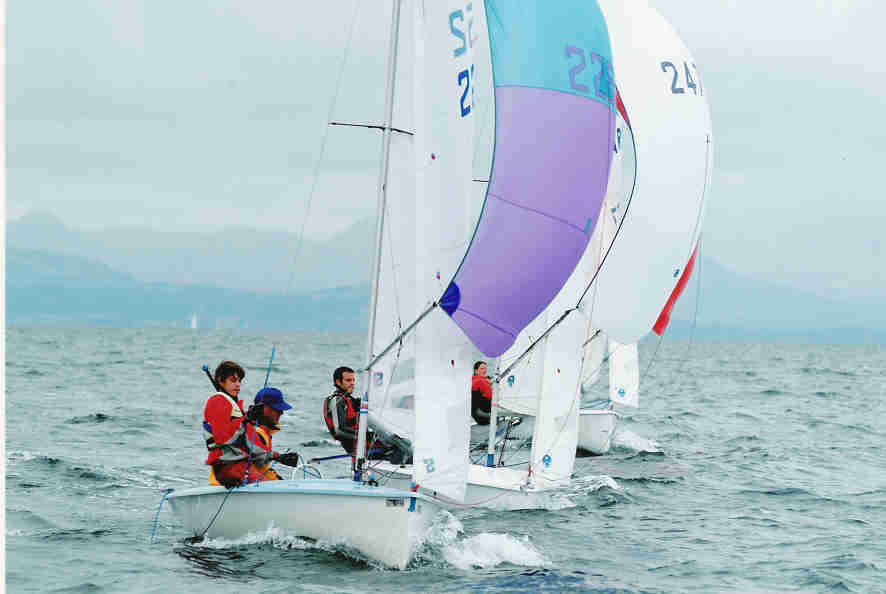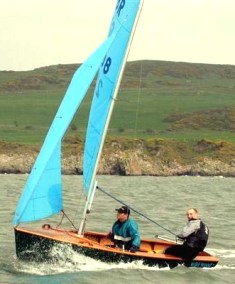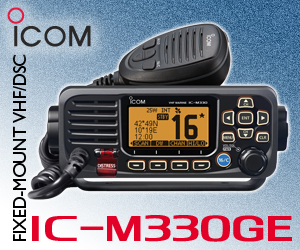What does mast rake do? |
Post Reply 
|
Page 123 4> |
| Author | |
timeintheboat 
Really should get out more 
Joined: 01 Feb 07 Location: United Kingdom Online Status: Offline Posts: 615 |
 Post Options Post Options
 Quote Quote  Reply Reply
 Topic: What does mast rake do? Topic: What does mast rake do?Posted: 08 May 07 at 7:52pm |
|
Upwind in hiking weather it seems a good thing. In the medium stuff life still feels better balanced up wind with some rake, but in the light stuff I haven't a clue what's going on. What is supposed to be happening to pointing with mast rake? Is it purely a de-powering thing?
These are on both single handers and double handers with adjustable mast rake around the course. I just reach for the rake control automatically around the leeward mark. |
|
|
Like some other things - sailing is more enjoyable when you do it with someone else
|
|
 |
|
BBSCFaithfull 
Really should get out more 
Joined: 06 Dec 05 Location: United Kingdom Online Status: Offline Posts: 1251 |
 Post Options Post Options
 Quote Quote  Reply Reply
 Posted: 08 May 07 at 8:03pm Posted: 08 May 07 at 8:03pm |
|
Straight mast in lighter winds
|
|
|
Greatfully Sponsored By
www.allgoodfun.com Int 14 GBR 1503!! |
|
 |
|
Garry 
Really should get out more 

Joined: 18 Apr 04 Location: United Kingdom Online Status: Offline Posts: 536 |
 Post Options Post Options
 Quote Quote  Reply Reply
 Posted: 08 May 07 at 9:36pm Posted: 08 May 07 at 9:36pm |
|
Sorry I disagree Alex (unless by straight you mean more upright) in light winds you want flatter open sails which means some bend, no kicker and no cunningham. As the wind picks up you want a straighter mast and wind on the kicker to get the leech working and then as you become over-powered you need to start bending it again, loads of kicker and cunningham. Rake is different you want the mast more upright in light winds and then rake back as the wind increases. However, if your rake is adjustable on the water then you rake backwards for upwind and forwards downwind. If you don't have the ability to change it on the water then you need to set up rake to get the correct compromise between upwind and down for the wind strength. However, don't rake too much in light winds as it opens the slot between jib and main losing power. Your class association should be able to give you some general advice. read Lawrie Smith's tuning your dinghy book, a bit dated now but still a good source of basic general information. That's a pretty basic summary there are bound to be specific exceptions. |
|
|
Garry
Lark 2252, Contender 298 www.cuckoos.eclipse.co.uk |
|
 |
|
NickA 
Really should get out more 
Joined: 30 Mar 05 Location: United Kingdom Online Status: Offline Posts: 784 |
 Post Options Post Options
 Quote Quote  Reply Reply
 Posted: 08 May 07 at 11:28pm Posted: 08 May 07 at 11:28pm |
|
I noticed in the heavy weather of the recent BNMT that all the contenders had let their kickers off somewhat in the gusty 20knot wind. Tried it, it seemed to help. I guess it lets the top of the sail blade off depowering the top of the sail and reducing heeling force - but surely it makes the sail fuller too. Confusing innit. NB: on the 3000 we raked the mast back to open the slot up to allow our new roachy jib to work better. An open slot I'm told, is a good thing.
|
|
|
Javelin 558
Contender 2574 |
|
 |
|
dopamine 
Groupie 
Joined: 26 Oct 06 Location: Burkina Faso Online Status: Offline Posts: 68 |
 Post Options Post Options
 Quote Quote  Reply Reply
 Posted: 09 May 07 at 10:17am Posted: 09 May 07 at 10:17am |
|
|
 |
|
Noah 
Really should get out more 
Joined: 29 Dec 04 Location: United Kingdom Online Status: Offline Posts: 611 |
 Post Options Post Options
 Quote Quote  Reply Reply
 Posted: 09 May 07 at 10:47am Posted: 09 May 07 at 10:47am |
|
As I understand it, the raking back in stronger winds helps to induce bend in the mast because the shroud / spreader / chainplate etc angles change. This might help to explain why - about a zillion years ago - sailing a GP with my Dad (we weighted about 19st all up) we could not depower the thing - no spreaders!.
|
|
 |
|
Stefan Lloyd 
Really should get out more 
Joined: 03 Aug 04 Online Status: Offline Posts: 1599 |
 Post Options Post Options
 Quote Quote  Reply Reply
 Posted: 09 May 07 at 3:13pm Posted: 09 May 07 at 3:13pm |
|
Not really, because some boats can adjust mast bend and rake independently but still increase rake upwind as the breeze builds. I've never read a convincing account of why increased rake depowers the rig but it clearly does. |
|
 |
|
WildWood 
Posting king 

Joined: 14 Nov 06 Location: United Kingdom Online Status: Offline Posts: 136 |
 Post Options Post Options
 Quote Quote  Reply Reply
 Posted: 09 May 07 at 4:14pm Posted: 09 May 07 at 4:14pm |
|
I've always found the genal rule 'if it looks nice then it's fast' works with sail trimming. For example an over sheeted sail with too much kicker looks terrible and isn't quick. Generally speaking it's best to keep looking at your sails and trying to get them sitting the best you can, unless you have gone to the lengths of working out exactly what settings you need for what wind strength.Mast rake and mast bend are obviously quite different things, mast bend affecting how full the main sail is, while mast rake alters the centre of effort of the rig and has a fundamental affect on the balance and handling of the boat, again generally speaking I think more rake will improve upwind performance, and less rake improves down wind speed. |
|
 |
|
Garry 
Really should get out more 

Joined: 18 Apr 04 Location: United Kingdom Online Status: Offline Posts: 536 |
 Post Options Post Options
 Quote Quote  Reply Reply
 Posted: 09 May 07 at 4:58pm Posted: 09 May 07 at 4:58pm |
Increasing rake opens the slot (depowering) and move the Centre of effort aft. You can then lift the centreboard slightly moving the centre of lateral resistance aft. |
|
|
Garry
Lark 2252, Contender 298 www.cuckoos.eclipse.co.uk |
|
 |
|
Garry 
Really should get out more 

Joined: 18 Apr 04 Location: United Kingdom Online Status: Offline Posts: 536 |
 Post Options Post Options
 Quote Quote  Reply Reply
 Posted: 09 May 07 at 5:00pm Posted: 09 May 07 at 5:00pm |
|
If you get the channce go to one of Adam Bower's talks on rig tuning, he puts all this in a simple and effective way. |
|
|
Garry
Lark 2252, Contender 298 www.cuckoos.eclipse.co.uk |
|
 |
|
Post Reply 
|
Page 123 4> |
| Forum Jump | Forum Permissions  You cannot post new topics in this forum You cannot reply to topics in this forum You cannot delete your posts in this forum You cannot edit your posts in this forum You cannot create polls in this forum You cannot vote in polls in this forum |
Copyright ©2001-2010 Web Wiz
Change your personal settings, or read our privacy policy












-(1)-202408140552.gif)










 Printable Version
Printable Version Delicious
Delicious Digg
Digg Facebook
Facebook Furl
Furl Google
Google MySpace
MySpace Newsvine
Newsvine reddit
reddit StumbleUpon
StumbleUpon Twitter
Twitter Windows Live
Windows Live Yahoo Bookmarks
Yahoo Bookmarks Topic Options
Topic Options